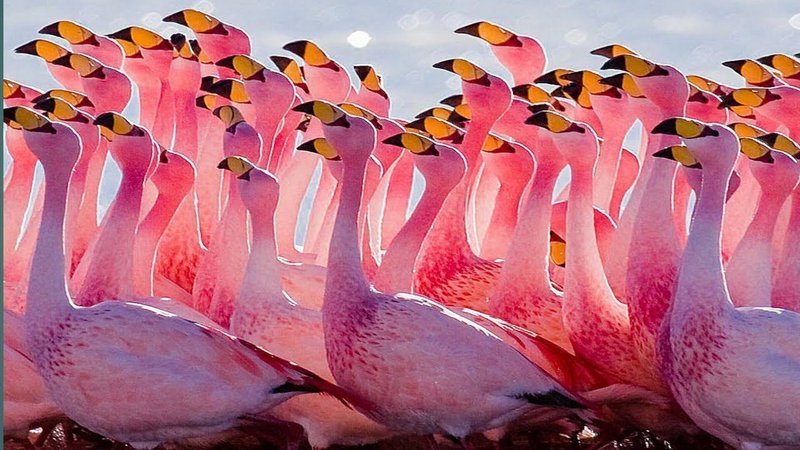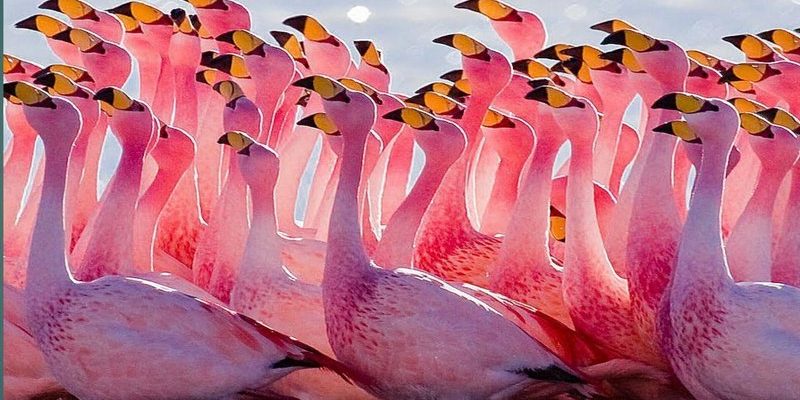
Imagine watching a ballet performance where the dancers glide gracefully across the stage. That’s a bit like how flamingos fly—elegant yet powerful. Their hunting techniques are just as impressive, showcasing a blend of skill and adaptation that allows them to thrive in their habitats. So, let’s dive into the world of flamingos and uncover their unique flying and hunting techniques.
How Flamingos Fly: The Art of Graceful Flight
Flamingos are designed for flight. Their long wings, which can measure up to 3.3 feet, help them soar for miles with minimal effort. When they take off, you might notice that they often run a few steps before lifting into the air. This is similar to how a sprinter builds momentum before a race. They flap their wings with strong, steady beats that propel them into the sky.
Here’s the thing: flamingos are not just about raw power. They have a smooth, gliding flight that allows them to conserve energy. As they soar, their long necks and legs extend, creating a striking silhouette against the backdrop of the sky. When flying in formation, they often create a V shape, just like geese, which reduces wind resistance and makes it easier for the entire flock to travel long distances together.
Another interesting fact about flamingos is the way they navigate during their flights. They have an incredible sense of direction and can travel hundreds of miles without losing their way. Scientists believe they use a combination of environmental cues, like the position of the sun and the magnetic field of the Earth, to stay on course. It’s impressive how a bird weighing just a few pounds can embark on such grand journeys!
Hunting Techniques: The Flamingo’s Culinary Skills
When it comes to feeding, flamingos have some of the most unique techniques in the bird kingdom. They primarily feed on algae, crustaceans, and small invertebrates found in shallow waters. Just like a chef selecting the right ingredients, they use their specialized beaks to sift through the water and find their meals.
Flamingos have a unique feeding technique called “filter feeding.” With their upside-down beaks, they can sift water through their bills, trapping tiny organisms. It’s as if they’re using a strainer instead of a spoon! They dip their heads into the water, pump their beaks to create a suction, and then carefully close them to trap food inside. It’s a bit messy, but that’s part of the fun of eating for flamingos!
One might wonder why they choose to eat in such a peculiar way. Here’s the catch: this method is highly effective in their preferred habitats, which are often rich in nutrients. Flamingos have a knack for thriving in environments where other birds might struggle. Their diet not only supports their health but also contributes to their stunning pink coloration. The carotenoids found in their food play a big role in that beautiful hue!
Group Dynamics: Teamwork in Flight and Feeding
Flamingos are highly social creatures, often found in large colonies that can number in the thousands. These flocks provide a sense of security and make the process of hunting more efficient. When feeding together, flamingos often synchronize their movements, creating a beautiful spectacle of pink elegance in the water.
This teamwork isn’t just for show. By feeding in groups, flamingos can stir up the mud and water, revealing more food sources. It’s like having a dinner party where everyone is pitching in to cook. When they flap their wings or move together, they create currents that can bring their desired snacks to the surface.
Flying in flocks also enhances their safety. With so many eyes watching for potential predators, individual flamingos can relax a little more while keeping an eye on their surroundings. It’s a classic case of “safety in numbers” that plays a significant role in their survival.
The Role of Habitat in Flying and Hunting
The habitats where flamingos live significantly influence their flying and hunting techniques. These birds are often found in shallow lakes, lagoons, and estuaries with plenty of mud and salt flats. The quality of these environments directly affects their food sources and overall health.
In these areas, they benefit from the rich biodiversity and the abundance of algae and other nutrients. A habitat that thrives with life allows flamingos to flourish. However, they are also sensitive to changes in their environment. Pollution and habitat destruction can drastically impact their food sources.
This connection between habitat and behavior highlights the importance of conservation. Maintaining healthy ecosystems is crucial for the survival of flamingos and their unique techniques for hunting and flying. It’s a reminder that with every flight and meal, these birds are closely tied to the health of their environment.
Flamingo Behaviors: More Than Just Flying and Feeding
While flying and hunting are essential aspects of a flamingo’s life, their behaviors extend beyond these activities. For instance, mating displays involve elaborate dances that showcase their vibrant colors and synchronized movements. These displays are not just for attracting mates; they also strengthen social bonds within the group.
Flamingos often engage in preening, where they use their beaks to clean their feathers. This helps maintain their plumage and ensures they are flight-ready at all times. It’s like a little grooming ritual before heading out on a big day.
Additionally, they communicate with each other through various vocalizations and body language. Each sound can convey different messages—whether it’s signaling alarm, courtship, or simply socializing. This social aspect of their lives is fascinating and adds another layer to their already rich existence.
Flamingos are so much more than just pretty birds; they are marvels of nature with unique flying and hunting techniques that set them apart. Their graceful flights and specialized feeding habits demonstrate how well they’ve adapted to their environments. By working together in flocks, they create a community that thrives on teamwork.
As we cherish these beautiful creatures, let’s also remember the importance of protecting their habitats. Their survival depends on healthy ecosystems where they can continue to showcase their stunning abilities. So, whether you’re watching them soar across the sky or feeding delicately in the water, take a moment to appreciate the flamingo’s incredible journey through life.

